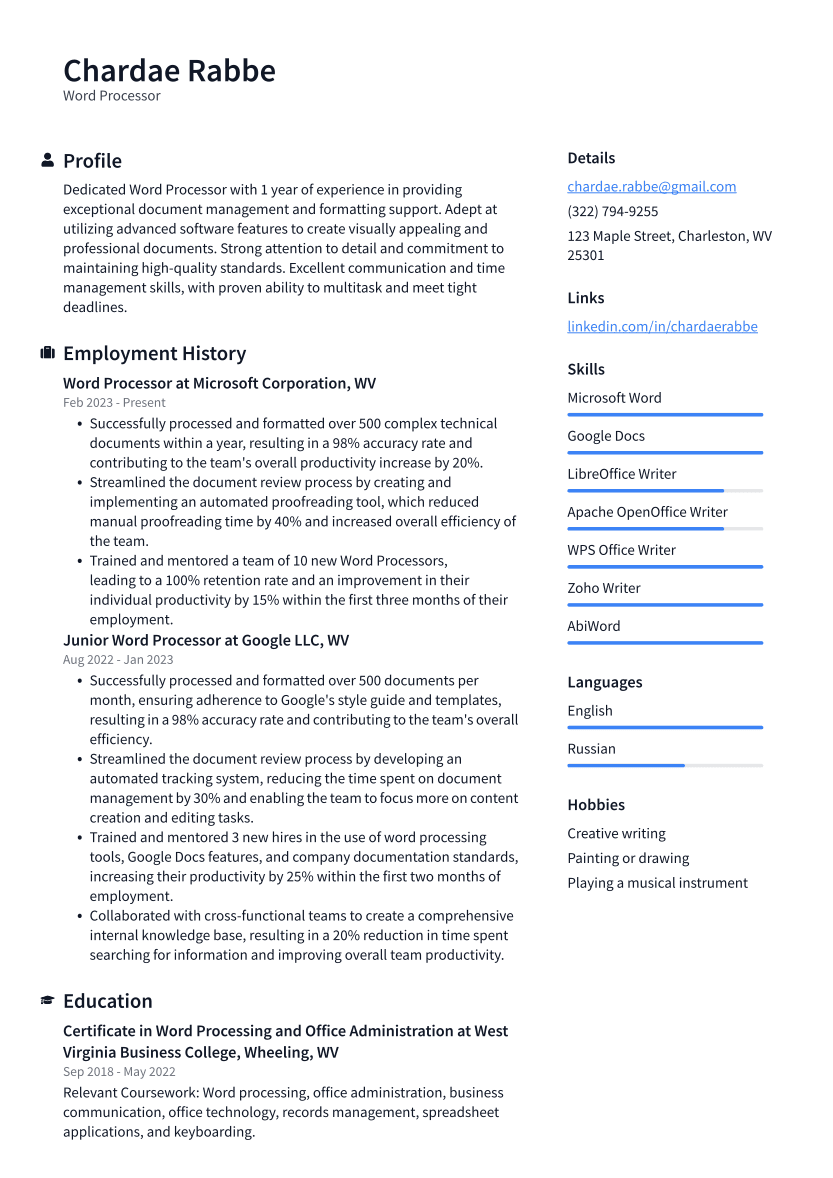Word Processor Resume Examples
Writing a great word processor resume is important because it is one of the first things a potential employer will see when they are considering you for a position. It is your opportunity to make a good first impression and sell yourself as the best candidate for the job.
Create your resume
Select from 7 professional resume templates
If you're looking for inspiration when it comes to drafting your own word processor resume, look no further than the samples below. These resumes will help you highlight your experience and qualifications in the most effective way possible, giving you the best chance of landing the word processor job you're after.
Essential Components of a Word Processor Resume
Creating a standout Word Processor resume is crucial for job seekers. It's the first impression you make on potential employers, showcasing your abilities, work history, and professional achievements. A well-crafted resume can significantly enhance your chances of landing an interview. Let's explore the essential elements of a Word Processor resume, discuss their significance, and offer tips to optimize each section.
Contact Information
At the top of your Word Processor resume, prominently display your Contact Information. This allows employers to contact you for further discussions or job offers.

Include your full name, phone number, and professional email address. Ensure accuracy to avoid missed opportunities. While a home address is optional, consider adding it if relevant to the job location. Include links to professional profiles like LinkedIn or a personal portfolio website, ensuring they present a professional image.
Keep the formatting simple and readable, avoiding distracting fonts or colors. Remember, this section, while seemingly straightforward, is crucial for facilitating the next steps in the hiring process.
- Name
- Phone Number
- Email Address
- Home Address (if applicable)
- Professional Profiles (LinkedIn, personal website, etc.)
Objective or Summary Statement
The Objective or Summary Statement serves as a brief introduction to your professional profile. It should succinctly highlight your word processing skills, experience, and career aspirations.
Align this statement with the job description, emphasizing your proficiency in word processing software, typing speed, and any industry-specific experience. Use an Objective Statement to convey your career goals if you're new to the field or transitioning careers. Experienced professionals should opt for a Summary Statement to recap their relevant expertise and accomplishments.
Given that hiring managers often skim resumes, craft your statement to capture attention immediately.
Work Experience
The Work Experience section is a detailed account of your professional background. Highlight roles that demonstrate your proficiency with word processing tasks, emphasizing responsibilities and achievements that align with the Word Processor position you're targeting.
List your employment history in reverse chronological order, including job titles, employment dates, and key responsibilities. Use action verbs to start each bullet point, adding impact to your experiences.
Skills and Abilities
The Skills and Abilities section is where you showcase the specific talents that qualify you for a Word Processor role. Include typing speed, software expertise, attention to detail, organizational skills, communication abilities, confidentiality, and adaptability. Provide examples to illustrate how you've applied these skills in practice.
Education and Certifications
Your Education and Certifications lend credibility to your resume, especially for roles where experience is limited. List relevant degrees, diplomas, and certifications, starting with the highest level of education. Highlight coursework pertinent to word processing and any additional certifications that demonstrate your commitment to professional development.
Awards and Achievements
The Awards and Achievements section can distinguish you from other candidates. Include any recognition received for your work in word processing or related fields, detailing the award, the issuer, and the reason for the accolade. This section underscores your expertise and the value you bring to potential employers.
References
While the References section is often positioned at the end of the resume, it's a powerful tool for validating your professional capabilities. Choose references who can vouch for your work, such as former supervisors or colleagues. Obtain their consent before listing them and provide their full names, titles, companies, and contact information. If the job listing doesn't request references upfront, include a note stating they are available upon request.
Remember, your resume should not only list your experiences but also demonstrate the impact of your contributions. Keep your references informed about your job applications so they can tailor their recommendations accordingly.
